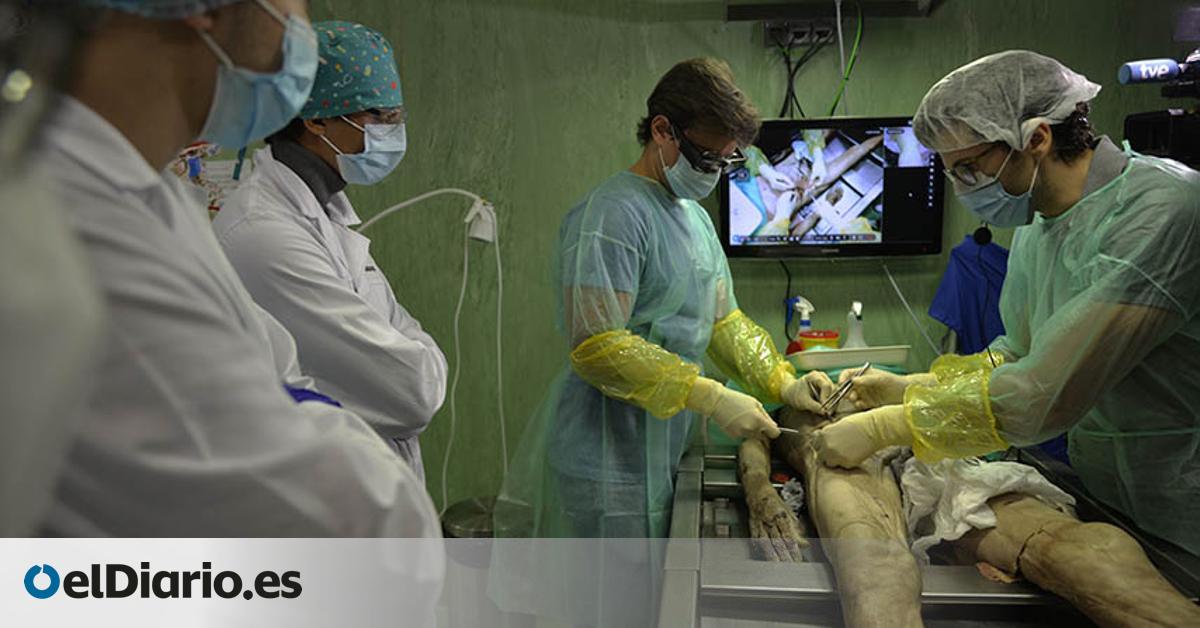
The president of Castilla y León, Alfonso Fernández Mañueco, announces that he will open Medicina in León and Burgos next year. In the Valencian Community, the intention of the University of Alicante (UA) to establish the degree has opened a war with the Miguel Hernández de Elche, both public. The University of Huelva inaugurated these studies last year due to the grievance that it felt, it claimed, to be “the only Andalusian province that did not have it.” In that same autonomous community, the ten public rectorates tried by all means – without success – to prevent the recently created (and private) Loyola University from launching the medical degree program in the middle of the course last year. In five years these degrees have been created in several private universities, so that in communities like Madrid there are already more students on these campuses than on public ones.
The drive to open a medical school spreads throughout Spain. In public and private universities. The autonomous communities have launched these studies in their universities while approving new courses in private centers. The proliferation of these centers – with great demand from students – arises as a response to the publicized lack of doctors that the country suffers. In 2008 there were 28 centers, in 2019 there were 42 and for next year there will be 56, according to forecasts. But they are opened against the criteria of the Ministry of Health, the deans of those that already exist and the students. They all believe, they have been saying it for years, that it will be counterproductive.
“It represents an educational, healthcare, economic, social and labor problem,” expressed the National Conference of Deans of Spanish Medical Faculties (CNDFME) and the State Council of Medical Students (CEEM) in a document still in force today. “The problem is complex but the solution is not to increase the number of medical schools. When completing this analysis, we must take into account factors such as the location of the job offer, the type of hospital or center, the type of care model that we are going to adopt, the behavior of private medicine, the role of nursing, etc.
The problem, explains Pilar López, dean of the Faculty of Medicine of the Autonomous University of Madrid, is that the diagnosis is done regularly (there is a lack of doctors, yes, but not of all types, only of some specialties) and therefore the solution is wrong. “In recent decades the number of graduates has increased, but that does not solve the lack of professionals. No matter how much the supply increases, if certain positions are not filled, we are doomed to increase unemployment in the area in some years and there will still be no solution,” he warns.
The Spanish paradox of the lack of (some) doctors and the surplus of students has a relatively simple explanation, according to the deans: it is the working conditions in those positions that cannot now be filled, either because they are unattractive specialties, or due to the circumstances of the positions (rural, isolated, saturated with workload, relatively little paid). “The demands of doctors are very clear: stability, salary improvements and elimination of bureaucracy,” the deans maintain.
The numbers say that Spain already has more than enough students, that opening more centers will deteriorate the quality of what already exists (for example, reducing places for internships) or that it will aggravate the lack of teachers, a silent problem that already affects students. centers
It’s not just that allowing more students won’t solve the problem, it can make it worse, deans and students warn. Among their arguments, opening more centers will deteriorate the quality of what already exists (for example, reducing places for internships) or due to the lack of teachers, a silent but serious problem that worries the centers. Health maintains that it is necessary to expand the places offered, but not the faculties that teach the degree, and even less so if they are private, as the Secretary of State, Javier Padilla, explained to this newspaper.
“The important thing is that the planning is coherent,” he maintains. “In recent years, long-term planning has begun. Supply-need reports are used, which have detected that a small increase of 15% and a greater supply of specialized health training places is necessary. [el MIR]but not in all of them. An attempt is made to increase more those that are most needed. We believe that it is not necessary to create more faculties, but rather to reinforce the existing ones. Yes, it is necessary to increase the number of clausus in the existing faculties, even with agreements with other hospitals,” explains Padilla.
The second country with the most faculties in the world
Statistics say that in Spain in the 2023-24 academic year, the last one with detailed data, there were 44,666 medical students. There are 1,313 more (3%) than in 2015 and just 3% more than in the previous year, despite the fact that theoretically the places should have increased by 15%. Even so, the fine print of this statistic shows that public faculties have lost 928 students in this period, while private faculties have gained 2,241, which in absolute terms seems few, but in percentage it is 33% more. There is a similar evolution with graduates: those from the public are basically stagnant in the last eight years (113 less), those from the private have almost doubled (in small numbers, they went from 700 to 1,200 last year).
The offer today includes 53 faculties, 15 of them private. It is a rate of more than one faculty per million inhabitants, which places the country as the second most in the world, second in the world, according to the deans. The ideal, they maintain, citing the WHO, is one center for every two million citizens.
These global figures hide nuances. There are students of morebut there is a lack of doctors in some specialties and in addition the graduates are still fewer than the places that leave the MIR each year, calls that despite this are filled with people who come from other countries or the so-called recirculators, who return to the MIR to do another specialty for various reasons. “Given the insufficient number of students graduating from medical schools in relation to the offer of Specialized Health Training places (MIR) and the needs of specialists in some specialties, such as Family and Community Medicine, we “The aim is to promote an increase in the offer of the degree in Medicine,” the department explained in a press release after meeting with the deans to address the issue.
Undesirable effects
This excess of powers produces various dysfunctions, experts warn. One of them, which does not occupy a place in the public conversation but “is of great concern” to the deans, is the lack of teachers for these health training courses. “The deficit in existing teaching staff is very serious and we have been warning about it for a long time without any action being taken in this regard,” lament the rectors, who point to a “decrease in medical teaching staff in basic areas and a decrease in permanent teaching staff in general.” and, especially, the linked one.”
Although it does not occupy a prominent place in the public conversation, deans are very concerned about the lack of teaching staff for these grades: there is currently a deficit of almost 4,000 teachers, and it is only going to get worse
In the decade between 2017 and 2026, 43% of the permanent teaching staff will have retired: 55% of the linked teaching staff in clinical areas, 34% of the non-linked teaching staff in clinical areas and 32% of the teaching staff in basic areas. “In a few years the situation will be unsustainable,” they warn. Already today there is a deficit of 3,800 teachers.
Another effect of raising the offer is that the entire internship system suffers. “On the one hand, increasing the number of medical faculties in each province, especially in those that already have one, means having to share infrastructure between several faculties such as University Hospitals and Health Centers, necessary for carrying out internships. clinics. This leads to more students per internship doctor-tutor, saturation of consultations and more work for the professional, to the detriment of both the students’ training and the quality of care,” say the deans.
From vocational training to university
This circumstance, which the deans warn about, is already a reality in the health studies of Vocational Training in the Community of Madrid, where the emergence of private centers has monopolized the places for internships, causing part of the public students to be unable to complete their studies in a timely manner.
The Madrid deans now fear that the FP was only a dress rehearsal to transfer the model to the university. The Government of Isabel Díaz Ayuso has the intention – it is reflected in an official draft with the first ideas for the new regional university law – to establish “a single district” in which all universities (public and private) compete for the same places. for practices. “This is worrying in the public sector because private companies can offer an economic incentive for the centers that offer internships. We would not be on equal terms and if this breaks out in this way our system will be harmed. It is a serious threat to universities and students. Access to a public career, for which a very high cut-off grade is required, is not the same as access to a private one, which is done only by paying. They cannot be the same rules of the game for everyone because they do not play the same game,” reflects López, dean of the UAM.
Beatriz González López-Valcárcel, professor of Economics at the University of Las Palmas and expert in health planning, is clear about the motivations of both. And, according to his explanation, it does not seem that any of the parties is thinking about what is best for the system: “The opening of public universities responds to the motivations of political parties, more than the university system and is a political decision,” he explains. . “In the case of Castilla y León, as they have difficulties filling places in the less populated provinces, having hospitals where students do internships could tend to stay later instead of going to large capitals. That’s why politicians may think it’s a good idea. But with private companies it is different: it is a very profitable business. The cost of graduating and the price of tuition [unos 20.000 euros anuales, según el centro] is favorable. They have benefits, it is a motivation that has nothing to do with it,” he maintains.
Source: www.eldiario.es

